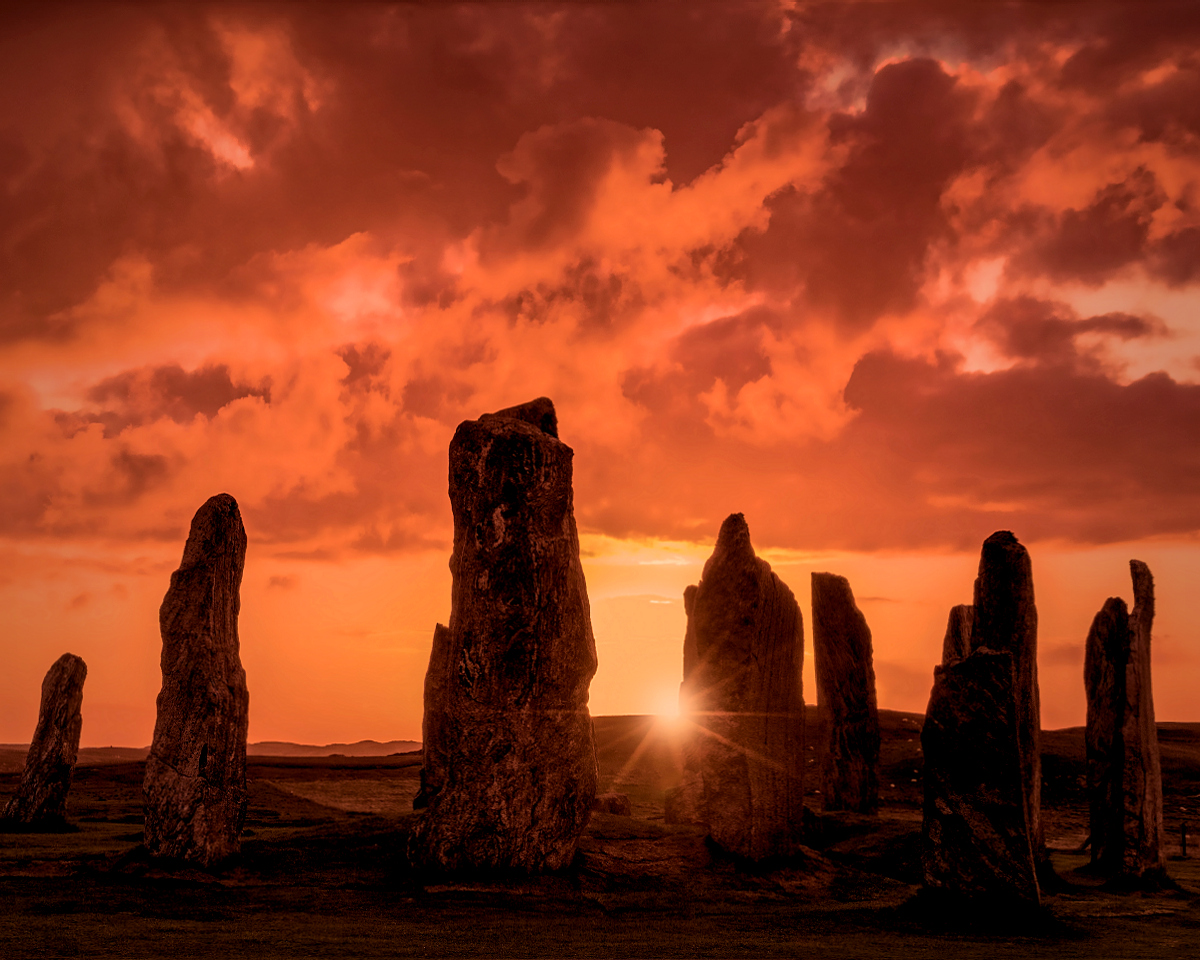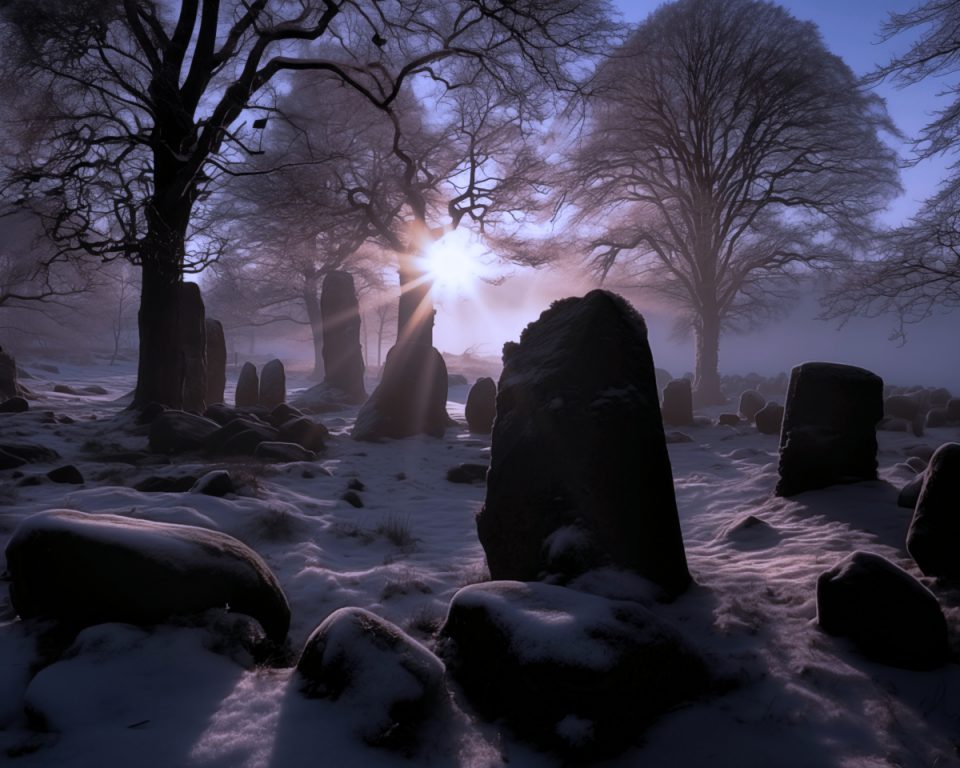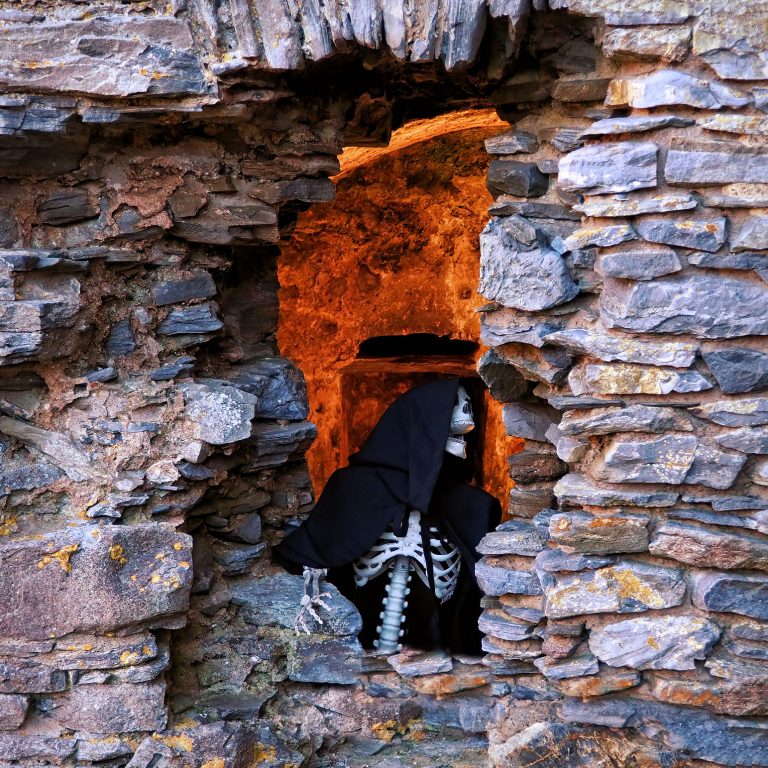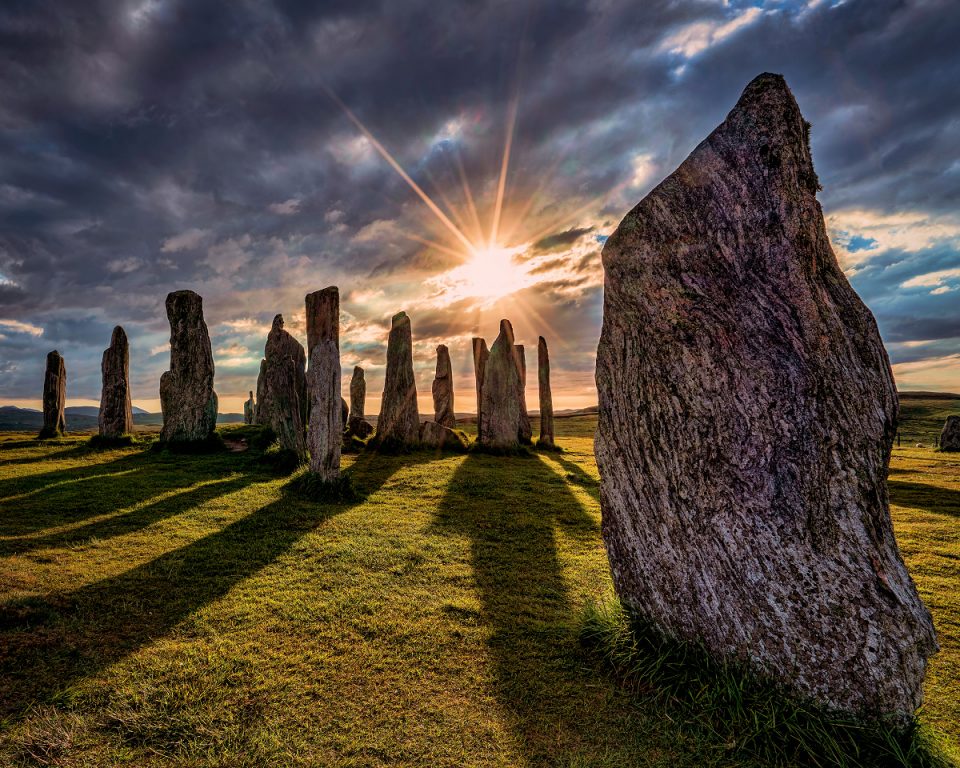Many people visit the Calanais Stones, on the Isle of Lewis at sunrise on the Summer solstice. They have heard a legend about the arrival of the ‘Shining One’ and go there in the hope of catching a glimpse of this being. But what is the story behind the myth and why are the Calanais Stones so important?
The Calanais Stones and the Stones of Stenness are perhaps Scotland’s oldest manmade structures. At over 5000 years old, they pre-date the pyramids of Egypt. They pre-date the mighty Stonehenge by some 500 years. Shrouded in mystery, nobody knows why they were built and yet there is an almost magical feel about them. It would have taken vast effort, manpower and time to build these structures.
The builders were early farmers and their survival depended on how much time they devoted to their husbandry. Why would they devote so much precious time to create these monuments? Were these lunar and solar observatories? Were they religious shrines where they worshipped their Gods and Goddesses or remembered their dead? Is it possible that these megaliths served more than one purpose? Could they relate to the Cailleach? What is it about these monuments that fascinates people so much?
Calanais: A Neolithic Complex
When archaeologists refer to the Calanais Stones they usually mean Calanais 1. There are a further two stone circles in the immediate vicinity of Calanais. An additional eight stone circles are found in a ten-kilometre radius of Calanais 1 as well as numerous single standing stones. Calanais 1 was built on a headland jutting into Loch Roag, a sea loch on the North West coast of Lewis. Whatever the purpose of the circle, it was designed to have a considerable visual impact. A similar pattern occurs in other places where megaliths are found in complexes rather than as solitary monuments. In Orkney, a number of Neolithic monuments are found in close proximity to the Stenness Circle. These include Maeshowe, Skara Brae and The Ring of Brodgar. At the Clava Cairns, a further fifty are found in the nearby Inverness and Moray Firth areas.
There is something haunting about the landscape, which gives the visitor the feeling that they are stepping far back into time. The bleak, desolate landscape with sparkling Gneiss domes and placid sea inlets creates an amazing backdrop for this monument. The vast skies and cloudscapes, with their ever-changing weather pattern, add to the atmosphere of the place. The stones are sunk into the peat of a windswept hillside where they appear to be reaching upwards to the sky, connecting the heavens and the earth. The stones themselves, weather-worn and cracked, combine with the ancient and rugged landscape giving them a presence that is inexplicable by modern-day logic. Perhaps they can only be truly understood if viewed from the mindset of the builders.
A Description of the Stones
To call Calanais a stone circle is an over-simplification. Certainly, it has a ring at its centre, but it is so much more than a group of stones arrayed in a circle. In fact, the ring is more of an ellipse rather than a true circle. The ring is comprised of 13 stones. In the centre of the ring is a giant monolith. Between the central pillar and the eastern stones of the ring lies a small chambered tomb. This is a later addition. Cremated human bones were found within the cairn as well as hundreds of pottery shards.
Projecting from the circle are three stone rows. These are found to the south, west and east of the circle, almost like a compass rose. However, instead of a row projecting from the north, there is a double row of stones or an avenue pointing north-eastwards.
The individual stones are of local Lewisian Gneiss. The stones are highly textured, with swirls amidst a contorted, glinting surface. It has been speculated that this was deliberate to give each stone a unique appearance. Many of the 49 erect stones have a tapered, or shouldered profile. On others, the uppermost edge is formed by a clean diagonal break. It is not certain whether these shapes represent a desired and designed outline or is a result of the way they were quarried.
Calanais 2 and 3
Callanish II, or Cnoc Ceann a’Gharaidb, still has five stones, ranging in height between 2.45 and 3.3 metres and is, in size, actually two and a half times bigger than the ring at Callanish I. Callanish III is named Cnoc Filibhir Bheag, and is located a mere ninety metres from the loch. It is an ellipse, 21.6 by 18.9 metres, and therefore this too, is bigger than Callanish I. When it was cleared of peat, bits of charcoal were found in holes, with pebbles from the seashore, and which may originally have held wooden uprights.
The History of the Stones
Archaeological excavations have demonstrated that Calanais 1 developed over a period of roughly 1000 years. It was built within a landscape which had an existing long tradition of agriculture. It seems that the construction of the monument began at around 3500BC with the erection of the central monolith. This was followed by the circle and then the rows and avenue. The chambered cairn was a later addition and was completed by 2500 BC.
It appears that the monument fell out of use around 1500 BC. At this point peat started to accumulate around the stones. In some places, the peat was over a metre taller than the shorter stones in the complex. In 1857 Sir James Matheson ordered the removal of the peat.
However, the true story of the stones is lost to time.
The Lore of the Calanais Stones
Perhaps by turning to folklore it is possible to unravel the mystery of who Calanais’ builders were and why they build this monument. Locally the stones are known as ‘Fir Bhreig’ meaning the false men in Gaelic. A legend states that the stones were once giants. Alas, they were turned to stone by St Kieran when they would not convert to Christianity.
In another tale, it is said that a white fairy cow came out of the sea during a year of harsh famine. The cow made its way to the stones and allowed itself to be milked by the people of the village. They were each allowed one pail of milk. A local witch came to the cow but when she tried to get two pails, she was refused. Enraged she returned with a sieve and proceeded to milk the cow dry.
Martin Martin visited in 1695 and wrote that “it was a Place appointed for Worship in the time of Heathenism, and that the Chief Druid or Priest stood near the big stone in the centre, from when he address’d himself to the People that surrounded him.”
The Shining One
Perhaps one of the most interesting folk traditions is that early on midsummer morning a being, known as the “Shining One”, walks the length of the avenue, his arrival heralded by the call of a cuckoo. This may be a folk memory of astronomical alignments or seasonal ritual at the site. Some researchers believe that the ‘Shining One’ might be a reference to Lugh, the bright, shinning Celtic sun-god. Others think this is a personification of fertility from a long-lost ritual.
This links to an insight arrived at by Aubrey Burl, who would marry hard scientific observations with Greek legends. He recounted that the Greek writer Diodus Siculus wrote about the legend of Hyperborea, which describes a temple on a faraway, northern island. “They say also that the moon, as viewed from this island, appears to be but a little distance from the earth and to have upon it prominences, like those of the earth, which are visible to the eye. The account is also given that the god visits the island every nineteen years, the period in which the return of the stars to the same place in the heavens is accomplished.”
The Apollo Connection with Calanais
Siculus, who lived in the first century BC, stated that at this temple, there was a “spherical temple” where Apollo “skimmed the earth at a very low height”. The common assumption was that the temple was Stonehenge and that Hyperborea was Britain. However, Burl realised that Stonehenge is five hundred miles too far south to have the correct lunar latitude to provide for a display as described. The Isle of Lewis, on the other hand, is perfectly positioned to match Siculus’ phenomenon.
Another legend linked with Callanish states that the stones were brought in ships under the leadership of a high priest and erected by “black men”.
Who built the Stones of Calanais?
The stones on the east side of the avenue are consistently about three-quarters as high as the stones on west side. This is a feature that is characteristic of northern Irish avenues and double rows and of those on the Crozon peninsula in western Brittany. It highlights that whoever built Callanish, they were perfectly aware of similar developments elsewhere in Europe, and followed the same “architectural trends”.
Some 35,000 megaliths or stone structures span the breadth of Europe. There has been a lot of debate as to whether they developed independently of each other or that they started from a single source then spread over sea routes. Swedish Researchers using statistical analysis have shown that megalith construction started in a single location in northwest France around 4500 BC. The tradition then spread through Europe spanning 2,000 years along the sea routes of the Mediterranean and Atlantic coasts, concentrated in coastal regions.
Is this what the legend referred to when it mentioned ‘black men’? Was it because they had the dark hair of the ancient French Men? The stones themselves came from Lewis. Yet is it possible, with the passage of time, events became muddled and it was the builders rather than the rock that arrived in boats?
Calanais and Astroarchaeology
It is now known that many of the megaliths in Scotland align with certain solar or lunar events. The Clava Cairns and Maehowe align with the winter solstice. The recumbent stone circles of northeastern Scotland align with the lunar standstill. The Ballochroy Standing Stones and Kist in Kintyre align with the summer solstice. Perhaps we should no longer be asking whether the Neolithic and Bronze Age communities in the British Isles integrated lunar or solar lines into some of their ritual monuments but why.
Recent research based on statistical analysis suggests that Calanais along with Stenness were the two forerunner sites for all the other standing stone monuments in Britain. The building of these stone circles marks the starting point for a ritual practice based on cosmological observation that would last for almost two millennia.
It seems that the Stone Circles, in part, acted as observatories. But would it be possible to decode Calanais’ astronomical clock?
Decoding Calanais
A group of Australian researchers examined the two oldest great stone circles built in Britain: Calanais and Stenness. To get a better idea of what they would have originally looked like, the team created 3D landscape models of the circles. To this, they added the surrounding landscape and the astronomical phenomena that would have been circling above.
Using these, they discovered that the sites share a combination of astronomical and landscape cues that were also found at smaller Bronze Age sites built more than 1,500 years later, on the nearby Scottish islands of Coll, Tiree, and Mull.
Notably, the Standing Stones of Stenness were actually built in the exact reverse order of the Callanish Stones.
At the Callanish site, the team found a specific pattern in the stones and the landscape, identifying seven different ‘cues’ that distinguished what they classified as a “classic” layout.
These cues include that the water occurred in the south and that the northern horizon was the closest, while the southern horizon was the most distant. The highest points of the horizon were marked by distinct mountains, and the summer and winter solstice Sun and standstill Moon tended to rise out of and set into, these high points.
Stenness: Calanais Reversed
When the team examined the Standing Stones of Stenness, it was an exact topographical ‘reverse’ of the Callanish site. Water was situated in the north, and the southern horizon was closest, while the northern horizon was the most distant.
Looking at the Callanish and Stenness sites, and the smaller sites that came after them, the team found that around half the sites featured the classic pattern, and the other half had the reverse.
Connecting the Skies and the Land
So the evidence suggests that 5,000 years ago, the ancient people of Scotland had managed to weave the sky and the land together in their stone circles to reflect the complex movements of the lunar and solar cycles at different stages. This practice was continued for at least another two millennia elsewhere in the country.
These chosen surroundings would have influenced the way the sun and the moon were seen, particularly in the timing of the rising and setting at special times like when the moon appears at its most northern position in the horizon which only happens every 18.6 years. This is known as the lunar standstill.
Calanais and the Lunar Standstill
The three stone circles at Calanais lie in the shadow of a hill range which appears to be in the form of a woman lying on her back. Did the Neolithic builders of the Stone circles see this as an Earth Mother? The local people call her “Sleeping Beauty” in English. In Gaelic, she is “Cailleach na Mointeach” or “The Old Woman of the Moors.” The Cailleach is also the Hag or Goddess of the Winter in Gaelic legend.
From Callanish 1, at the time of the lunar standstill, the moon rises over ‘Sleeping Beauty’s’ breasts. Then the moon passes through the Calanais Stones several hours later. The moon appears inside the circle. A beam of moonlight stretches down the Avenue. If a person stands on the rocky outcrop on the higher south end of the site, the moon is dramatically ‘reborn’ with a person silhouetted within it. The rocky outcrop is known as Cnoc na Tursa. It is a natural feature which seems to have been deliberately incorporated into the site.
Was this part of a ritual where an elite member of society, perhaps a priest or priestess took on a role which involved a dramatic interaction with the moon? Could this be the origin of the ‘Shining One’ Walking up the Avenue?
Calanais 3
From certain angles at Calanais 3, ‘Sleeping Beauty’ appears to be pregnant. There are those who propose that within this stone circle there are four significant stones:
- A phallic stone with quartz deposits, the Male Stone
- A triangular stone symbolic of the Maiden
- A rough Stone symbolic of the Cailleach or Crone, the Gaelic goddess of winter.
- A Red stone symbolic of the Mother which glows at sunset.
Thus, the stone circle is dedicated to the triple Goddess.
At the time of the lunar standstill, the moon rises at the feet of ‘Sleeping Beauty. Slowly begins moving across the stones. The Moon approaches the ‘Maiden’ Stone. It hovers over the Male Stone where it has been suggested that it is fertilised. Finally, it passes low over Sleeping Beauty’s face.
Calanais and the Wheel of the Year
It now seems probable that Calanais and Stenness were large observatories where the Neolithic people watched the heavens. Yet why go to such great lengths to build these monuments which would have taken generations to build?
It is easy to understand why the solstices would have been important. The Summer solstice would hail a time of long daylight hours, abundant food and mild weather. The winter solstice would mark the turning point of the long dark winter when hunger gnawed in your belly and the cold sunk deep into your bones. But why was the lunar standstill so important?
These were farmers, a people bound to nature, a people at one with the Earth and a people with a strong connection to their environment. Their very survival depended on how well they could adapt to their surroundings. Their very lives were bound to the cycle of the year. Did they see the cycles of the sun and moon in the skies as being symbolic of the farming year? Or of the cycle of their lives? The Circle was at the heart of their lives. They lived in roundhouses. Is it possible that they saw the stone circles as representing their deceased ancestors’ homes?
Calanais and the Goddess
Who has not looked into the night skies and wondered at the majesty of the heavens? Did they see something which made them feel like they were a small part of a vast cosmos? The movements in the heavens would have served as calendars and navigation tools. In a world without compasses, seafarers would need to find their way home. In a world before roads, the sea roads were the main means of transport. Yet the vastness of these stone monuments surpasses what is needed for survival by subsistence farmers. Did they see a connection between the heavens and their dead ancestors? Were they trying to understand their world through religion, possibly through a mother Goddess and hence their obsession with the Lunar Standstill? Could it have been some ritual re-enactment that involved a fertility rite?
Who were these mysterious people who travelled across Europe building these edifices? Were they a priestly cast- a kind of Neolithic missionary?
Are the legends we have associated with these stones, folk memories of a time when our early ancestors began to shape the land and began to make sense of their existence through ritualised performances which connected the earth with the skies. We often think of these people as primitive. However, the scale of these early monuments clearly demonstrates the social organisation, creativity, and engineering skills of these early people.
Interestingly, the account of Hyperborea states that the island was the birthplace of Leto, the mother of Apollo. Could this be a reference to the “Sleeping Beauty”, the Cailleach? The “Old Woman of the Moors”?
The next lunar standstill will occur in April 2025.
Please feel free to share the spooky by using the links below or leave us a message in the comments box.




